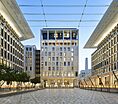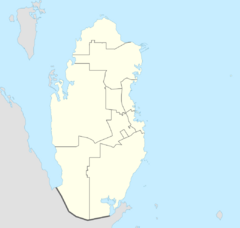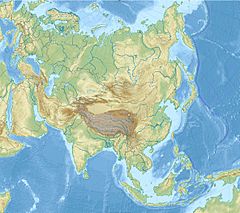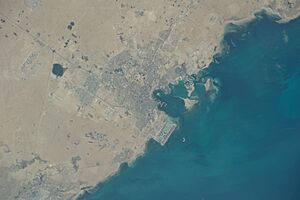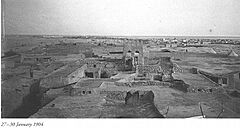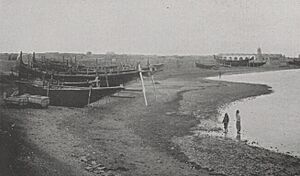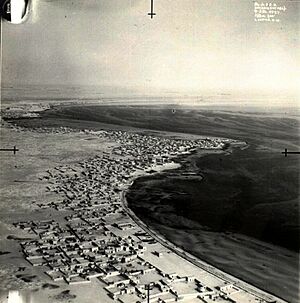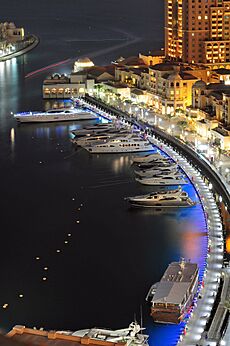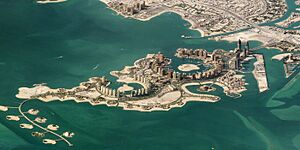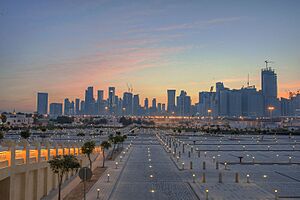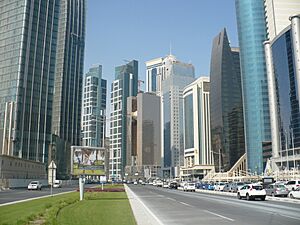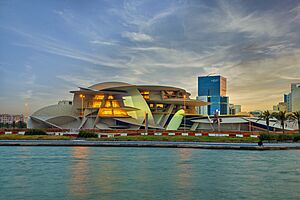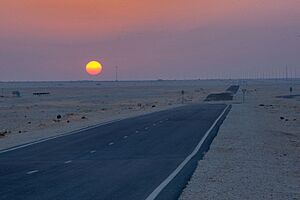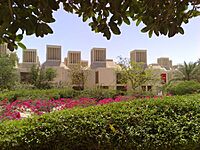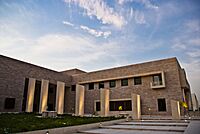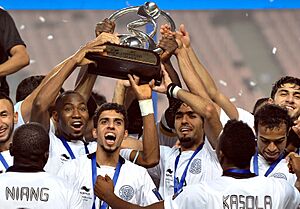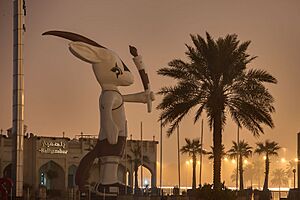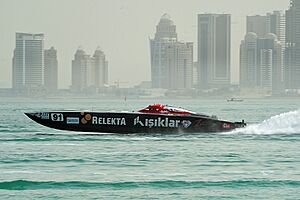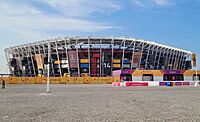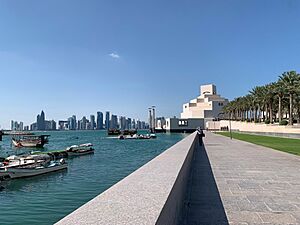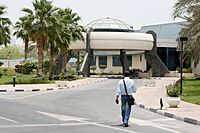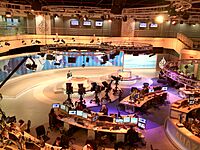Doha facts for kids
Quick facts for kids
Doha
الدوحة
|
|
|---|---|
|
Doha skyline
The Pearl Marina
Souq Waqif
National Museum of Qatar
Musheireb Downtown Doha
Katara Cultural Village
Museum of Islamic Art
|
|
| Country | Qatar |
| Municipality | Doha |
| Established | 1825 |
| Area | |
| • City proper | 132 km2 (51 sq mi) |
| Population
(2020)
|
|
| • City proper | 1,186,023 |
| • Density | 8,990/km2 (23,270/sq mi) |
| Time zone | UTC+3 (AST) |
Doha (Arabic: الدوحة, romanized: ad-Dawḥah) is the capital city of Qatar. It is also the main financial center of the country. Located on the Persian Gulf coast, Doha is home to most of Qatar's people. It is the fastest growing city in Qatar. Over 80% of the country's population lives in Doha or its nearby areas. These areas are known as the Doha Metropolitan Area.
Doha was founded in the 1820s. It grew from an older settlement called Al Bidda. In 1971, Qatar became independent from Britain. Doha was then officially named the country's capital. It is an important city for business in the Middle East.
Doha has hosted many major events. These include the 2006 Asian Games and the 2011 Pan Arab Games. It also hosted the 2022 FIFA World Cup. The city will host the 2027 FIBA Basketball World Cup. Doha is known as one of the safest cities in the world.
Contents
- City Name: What Does "Doha" Mean?
- Doha's Past: A Brief History
- Doha's Location and Environment
- People and Languages in Doha
- How Doha is Organized
- Doha's Economy
- Doha's Buildings and Design
- Getting Around Doha
- Learning in Doha
- Sports in Doha
- Doha's Culture
- Places to Visit in Doha
- Doha's Sister Cities
- Images for kids
- Famous People from Doha
- More to Explore
- See also
City Name: What Does "Doha" Mean?
The name "Doha" comes from the Arabic word dohat. This word means "roundness". It refers to the rounded bays along the city's coastline.
Doha's Past: A Brief History
Early Settlements: Al Bidda's Beginnings
Doha grew out of an older town called Al Bidda. The first mention of Al Bidda was in 1681. A German explorer, Carsten Niebuhr, mapped it in 1765. He called it 'Guttur'.
In 1801, a British official named David Seaton described Al Bidda. He said it was a town recently settled by the Sudan tribe. In 1821, a British ship attacked Al Bidda. This was because of claims of piracy. The town was destroyed, and many people had to leave.
Doha's Founding and Growth
Doha was founded near Al Bidda around the 1820s. John MacLeod, a British official, visited Al Bidda in 1823. He noted it was the main trading port in the area. Because they were so close, Al Bidda and Doha were often seen as one place.
In 1843, a powerful tribal chief, Isa bin Tarif, moved to Doha. He took control of the town. He died in a battle in 1847.
The Al Thani Family Arrives
The Al Thani family moved to Doha after 1847. They soon took control of the town. They sometimes supported the rulers of Bahrain and sometimes the Saudis.
In 1867, forces from Bahrain and Abu Dhabi attacked Doha and Al Wakrah. They destroyed many houses. This event led to a peace treaty in 1868. This treaty helped Qatar become recognized as a separate area. It also recognized Mohammed bin Thani as an important leader.
In 1871, the Ottomans came to Qatar. They set up a base in Doha. This was accepted by Jassim bin Mohammed Al Thani, who wanted to protect Doha from Saudi attacks. By 1893, disagreements led to the Battle of Al Wajbah. The Ottomans eventually surrendered.
Doha in the 20th Century
Pearling was very important to Doha's economy in the early 1900s. The city's population grew to about 12,000 people. However, the pearl market crashed in 1907. This caused a big drop in the population.
In 1913, the Ottomans left Qatar. In 1916, Qatar became a British protectorate, with Doha as its capital. Buildings were simple, made of mud, stone, and coral.
Oil was discovered in Qatar in 1939. This brought slow economic growth. But the pearl trade declined further due to cultured pearls and the Great Depression. Significant money from oil started coming in the 1950s and 1960s.
Doha began to modernize. Old areas were replaced with new buildings. The first boys' school opened in 1952, and a girls' school in 1955. The city's port was made deeper in the 1970s. This allowed bigger ships to enter. Doha's population grew from 14,000 in the 1950s to over 83,000 by the 1970s. Many foreign workers moved to the city.
Doha After Independence
Qatar became fully independent in 1971, with Doha as its capital. The University of Qatar opened in 1973. The Qatar National Museum opened in 1975. Old neighborhoods were redeveloped, and people moved to new suburbs. Doha's population continued to grow rapidly.
In 1983, the Sheraton Hotel was built. It was the tallest building in Doha for a while. Doha started hosting major sports events, like the ATP Qatar Open in 1993.
The Al Jazeera news channel started broadcasting from Doha in 1996. In the late 1990s, Education City was planned. This is a large area for schools and universities. Since 2000, Doha has gained global attention. It has hosted many international events and built huge new projects.
One big project is The Pearl-Qatar, an artificial island. It opened its first part in 2004. In 2006, Doha hosted the 2006 Asian Games. This led to the creation of Aspire Zone, a large sports complex. Old cultural sites like Souq Waqif were restored. Katara Cultural Village opened in 2010.
Doha also hosted the 2012 UNFCCC Climate Negotiations. The city continues to modernize while keeping its traditions. This is part of Qatar's long-term plan, Qatar National Vision 2030.
Doha's Location and Environment
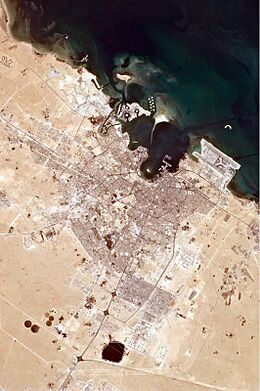
Land and Coastline
Doha is on the central-east coast of Qatar, next to the Persian Gulf. It is about 10 meters above sea level. The city has grown a lot through Land reclamation. This has added 400 hectares of land and 30 km of coastline. For example, half of Hamad International Airport was built on reclaimed land.
Wildlife and Plants
Street cats are common in Doha. They were first brought in the 1960s to control rodents. The Gulf short-fingered gecko is also found in coastal areas.
Common plants in Doha include creeping sorrel, winter cherry, and rye grass. You can also find qurdi near roadsides and indigofera near the central market. Flowers like sacred datura and wild chamomile are sometimes seen.
Islands and Water
The Pearl is a large artificial island in Doha. It covers almost 400 hectares. Other islands off Doha's coast include Palm Tree Island and Al Safliya Island.
In 2010, a survey of Doha's coastal waters was done. It found the water was about 2 to 7.5 meters deep. The water was salty and had an average temperature of 22.7°C.
Doha's Climate
Doha has a hot desert climate. Summers are very long and extremely hot. Average high temperatures from May to September are over 38°C. They often reach 45°C. Humidity is usually lowest in May and June.
Rainfall is rare, with only about 75 mm per year. Most rain falls between October and March. Winters are mild and warm during the day, and cool at night. Temperatures rarely drop below 7°C. The highest temperature ever recorded in Qatar was 50.4°C in Doha on July 14, 2010.
| Climate data for Doha (1992–2021, extremes 1962–2013) | |||||||||||||
|---|---|---|---|---|---|---|---|---|---|---|---|---|---|
| Month | Jan | Feb | Mar | Apr | May | Jun | Jul | Aug | Sep | Oct | Nov | Dec | Year |
| Record high °C (°F) | 32.4 (90.3) |
36.5 (97.7) |
41.5 (106.7) |
46.0 (114.8) |
47.7 (117.9) |
49.1 (120.4) |
50.4 (122.7) |
48.6 (119.5) |
46.2 (115.2) |
43.8 (110.8) |
38.0 (100.4) |
32.7 (90.9) |
50.4 (122.7) |
| Mean daily maximum °C (°F) | 22.6 (72.7) |
24.0 (75.2) |
27.7 (81.9) |
33.2 (91.8) |
39.4 (102.9) |
42.2 (108.0) |
42.4 (108.3) |
41.4 (106.5) |
39.2 (102.6) |
35.6 (96.1) |
29.7 (85.5) |
24.8 (76.6) |
33.5 (92.3) |
| Daily mean °C (°F) | 18.3 (64.9) |
19.4 (66.9) |
22.6 (72.7) |
27.4 (81.3) |
33.7 (92.7) |
36.4 (97.5) |
37.4 (99.3) |
36.6 (97.9) |
34.5 (94.1) |
31.0 (87.8) |
25.4 (77.7) |
20.6 (69.1) |
28.6 (83.5) |
| Mean daily minimum °C (°F) | 14.8 (58.6) |
15.8 (60.4) |
18.5 (65.3) |
23.0 (73.4) |
28.0 (82.4) |
30.5 (86.9) |
32.1 (89.8) |
31.8 (89.2) |
29.7 (85.5) |
26.5 (79.7) |
22.0 (71.6) |
17.2 (63.0) |
24.2 (75.5) |
| Record low °C (°F) | 3.8 (38.8) |
5.0 (41.0) |
8.2 (46.8) |
10.5 (50.9) |
15.2 (59.4) |
21.0 (69.8) |
23.5 (74.3) |
22.4 (72.3) |
20.3 (68.5) |
16.6 (61.9) |
11.8 (53.2) |
6.4 (43.5) |
3.8 (38.8) |
| Average precipitation mm (inches) | 11.2 (0.44) |
10.6 (0.42) |
17.1 (0.67) |
6.0 (0.24) |
1.2 (0.05) |
0.0 (0.0) |
0.0 (0.0) |
0.0 (0.0) |
0.0 (0.0) |
2.8 (0.11) |
10.8 (0.43) |
17.6 (0.69) |
77.3 (3.05) |
| Average relative humidity (%) | 75 | 73 | 66 | 57 | 49 | 46 | 53 | 62 | 63 | 66 | 69 | 74 | 63 |
| Mean monthly sunshine hours | 244.9 | 234.5 | 248.0 | 267.0 | 325.5 | 345.0 | 331.7 | 328.6 | 306.0 | 303.8 | 270.0 | 248.0 | 3,453 |
| Mean daily sunshine hours | 7.9 | 8.3 | 8.0 | 8.9 | 10.5 | 11.5 | 10.7 | 10.6 | 10.2 | 9.8 | 9.0 | 8.0 | 9.5 |
| Source: Qatar Meteorological Department (Climate Normals 1992–2021) | |||||||||||||
People and Languages in Doha
| Total population of the Doha Metropolitan Area | |
|---|---|
| Year | Metro population |
| 1997 | 434,000 |
| 2004 | 644,000 |
| 2008 | 998,651 |
Many people in Doha and its surrounding areas live close together. The city has grown very fast. Its population more than doubled from 2000 to 2010.
Who Lives in Doha?
Most people living in Doha are expatriates. These are people who come from other countries. Qatari citizens make up a smaller part of the population. Many expatriates come from South-East and South Asia. These include people from India, Pakistan, and the Philippines. There are also many expatriates from Arab countries, Europe, and North America.

Arabic is the official language of Qatar. English is often used as a second language, especially in business. Because of the many expatriates, other languages are also widely spoken. These include Malayalam, Tamil, Bengali, and Tagalog.
In 2004, a law was passed allowing non-Qatari citizens to buy land in certain areas of Doha. This includes places like The Pearl-Qatar. This law also gives them a renewable permit to live and work in Qatar.
Religion in Doha
Most people in Doha are Muslim. There are many mosques in the city.
There are also many Christians in Doha. The first Catholic church, Our Lady of the Rosary, opened in 2008. Other Christian churches also exist in Doha.
How Doha is Organized
City Districts
Doha is divided into many districts. In the 2010 census, there were over 60 districts. Some well-known districts include:
- Al Bidda (البدع)
- Al Dafna (الدفنة)
- Al Ghanim (الغانم)
- Al Markhiya (المرخية)
- Al Sadd (السد)
- Al Waab (الوعب)
- Bin Mahmoud (فريج بن محمود)
- Madinat Khalifa (مدينة خليفة)
- Musheireb (مشيرب)
- Najma (نجمه)
- Old Airport (المطار القديم)
- Qutaifiya (القطيفية)
- Ras Abu Aboud (راس أبو عبود)
- Rumeilah (الرميلة)
- Umm Ghuwailina (ام غو يلينه)
- West Bay (الخليج الغربي)
Some districts were originally settled by specific tribes. After Qatar became independent, many old districts were redeveloped. The government focused on new business areas like Al Dafna and West Bay.
Doha's Economy
Doha is the economic heart of Qatar. It is home to major oil and gas companies like QatarEnergy. The city's economy mainly relies on money from oil and natural gas.
Qatar has been working to make its economy more diverse. This means not relying only on oil and gas. They built Doha International Airport to boost tourism. This airport was replaced by Hamad International Airport in 2014. The new airport is much larger. Many new hotels have also been built.
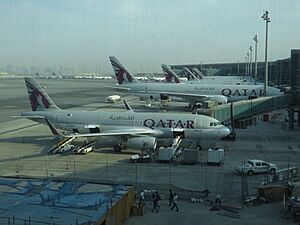
Real estate prices in Doha grew a lot, especially after Qatar won the bid to host the 2022 FIFA World Cup. Even with changes in oil prices, the government has continued to invest in building new areas.
Tourism and Shopping
Doha is a very important city for tourism in Qatar. The country is building new hotels and resorts. It is also promoting cultural places like the Museum of Islamic Art and Katara Cultural Village. Qatar Airways helps connect the country to major cities worldwide.
Qatar has hosted big international events like the FIFA World Cup 2022. This has brought many visitors and money to the country. High incomes in Qatar also create opportunities for restaurants and shops.
Qatar is working to grow other parts of its economy, like finance and technology. It has built world-class facilities like Hamad International Airport. It also offers support for new businesses. Doha was named the Arab tourism capital for 2023. It hosted the International Horticultural Expo 2023 in Al Bidda Park.
Doha's Buildings and Design
Old Buildings

In the past, Doha's buildings were made from local limestone. Walls were thick, about 0.4 to 0.6 meters. They were covered with mud or plaster. Roofs were flat, made with mangrove beams and palm mats. They were sealed with earth.
Many older buildings from the 1960s and 1970s have been taken down. This makes space for new ones. But there are efforts to save the city's history. Katara Cultural Village is a good example. It was built to preserve Qatar's cultural identity.
Modern Buildings
In the mid-1900s, Qatar started using modern building methods. They began using concrete blocks. Later, they used plain concrete blocks and reinforced concrete. New materials like plywood and metal were also introduced. Air conditioning became common.
In 2011, over 50 towers were being built in Doha. The Doha Convention Center Tower was the largest. However, its construction was stopped in 2012. This was due to concerns about flight traffic. The site is now being turned into a park.
Qatar has spent billions on new infrastructure projects. This was for the 2022 World Cup and other goals in the Qatar National Vision 2030.
Msheireb Downtown Doha is a huge project. It cost about $5 billion. It aims to restore and improve the historic downtown area.
Famous Buildings
- National Museum of Qatar (NMoQ): This museum opened in March 2019. Its design looks like a desert rose. It wraps around the old palace of Abdullah bin Jassim Al Thani. This connects Qatar's past with its present.
- Doha Tower: Also known as Burj Doha, this tall building is in West Bay. It won an award in 2012 for being the Best Tall Building Worldwide. It is 238 meters tall with 46 stories.
- Aspire Tower: Also called The Torch Doha, this 300-meter-tall hotel is in the Aspire Zone. It was a main feature for the 2006 Asian Games. It is the tallest building in Doha and Qatar.
- Museum of Islamic Art (MIA): This museum is at one end of the Doha Corniche. It was designed by I. M. Pei. It is built on an island near the traditional dhow harbor.
- Qatar National Library: This library opened in 2012. It provides over one million books to the people of Qatar.
- Msheireb Museums: These museums are part of Msheireb Downtown Doha. They celebrate the history of four old heritage houses. They show the traditional community lifestyle of the area.
City Design and Climate Control
In the past, Doha's buildings were close together. This provided shade and privacy. Thick stone walls helped keep buildings cool. Windows were small and often covered.
The badgheer system was used for air circulation. This included windcatchers and wall vents. Large open courtyards also helped air move through buildings.
Today, modern cooling technologies are used. These include air conditioning and other systems. There are also efforts to change working hours during hot summers. Some buildings use lighter materials to reflect heat. However, due to climate change, some areas of Qatar could become very difficult for humans to live in by the end of the 21st century.
Planned Communities
Lusail City is a large planned community north of Doha. It is expected to be finished by 2020. It is designed to hold 450,000 people. Al Waab City is another planned community. It will have homes, shopping malls, and schools.
Getting Around Doha
Qatar has invested a lot in improving Doha's transportation. Since 2004, the city has added new highways, a new airport, and a new seaport. A metro system also started operating in 2019.
Roads
Major highways in Doha include:
- Dukhan Highway, connecting to Dukhan.
- Al Shamal Road, connecting to Al Shamal.
- Al Khor Coastal Road, connecting to Al Khor.
- Salwa Road, connecting to the Saudi Arabian border.
- Al Majd Road, the longest highway in Qatar.
- Lusail Expressway, connecting to Lusail.
- F-Ring Road and G-Ring Road, linking different parts of the city.
The Sharq Crossing in Doha Bay is a future project. It will connect Hamad International Airport with Katara Cultural Village and West Bay.
Rail System
The Doha Metro has three lines that are currently working. These are the Red Line, Gold Line, and Green Line. The Blue Line is planned for completion in 2025. Msheireb Station is the main transfer point for all lines.
- The Red Line runs from Al Khor to Al Wakrah and Hamad International Airport.
- The Green Line connects Doha to Education City.
- The Gold Line runs from Old Airport to Al Rayyan.
- The Blue Line will cover the inner city of Doha.
Air Travel
Doha is served by Hamad International Airport. This is Qatar's main international airport. It opened in 2014, replacing Doha International Airport.
The airport is named after Qatar's former leader, Hamad bin Khalifa Al Thani. Hamad International Airport was named the World's Best Airport in 2021 and 2022.
Taxis
You can find taxis easily in Doha. Most taxis are part of the government-owned Mowasalat company. They are known for being clean and reliable. These taxis are bright turquoise. Ride-sharing apps like Careem and Uber are also available.
Learning in Doha
Doha is the main education center in Qatar. It has the most schools and colleges. The first formal boys' school opened in 1952. The first girls' school opened three years later. Qatar University, the first university, opened in 1973.
Education City is a large education complex. It was started in 2000 by Qatar Foundation. It has eight universities, a top high school, and offices for Al Jazeera's children's TV channel.
In 2009, the government started the World Innovation Summit for Education (WISE). This event brings together education leaders from around the world. They discuss important education topics.
Some universities in Doha include:
- Carnegie Mellon University in Qatar
- Georgetown University School of Foreign Service in Qatar
- Hamad Bin Khalifa University
- Cornell University
- HEC Paris in Qatar
- Northwestern University in Qatar
- Texas A&M University at Qatar
- UCL Qatar
- Virginia Commonwealth University
- Weill Cornell Medical College in Qatar
- Stenden University Qatar
- College of the North Atlantic
- Qatar University
- Qatar Faculty of Islamic Studies
- University of Calgary
Sports in Doha
Football
Football is the most popular sport in Doha. There are six Doha-based football clubs in the Qatar Stars League. These include Al Ahli, Al Arabi, and Al Sadd.
Doha has hosted many football tournaments. These include the 1988 and 2011 AFC Asian Cups. It also hosted the 1995 FIFA World Youth Championship.
In 2010, Qatar won the right to host the 2022 FIFA World Cup. Three new stadiums were built in Doha for the event. The Khalifa International Stadium was also expanded. Doha also hosted the 2019 FIFA Club World Cup and 2020 FIFA Club World Cup.
Basketball
Doha hosted the 2005 FIBA Asia Championship. Qatar's national basketball team finished 3rd, their best result ever. The city will host matches for the 2027 FIBA Basketball World Cup. Most teams in the Qatari Basketball League are based in Doha.
Volleyball
Doha has hosted the FIVB Volleyball Men's Club World Championship four times. It also hosted the FIVB Volleyball Women's Club World Championship three times.
Other Sports
In 2001, Qatar became the first Middle Eastern country to hold a women's tennis tournament. Doha also hosts other tennis events.
Doha hosted the 2006 Asian Games in December 2006. It spent $2.8 billion on preparations. The city also hosted the 3rd West Asian Games in 2005.
Doha tried to host the 2016 Olympics and 2020 Summer Olympics but was not chosen.
The MotoGP motorcycling grand prix is held annually near Doha. The city also hosts a round of the F1 Powerboat World Championship in Doha Bay.
In 2012, Doha was chosen to host the 2014 FINA World Swimming Championships (25 m) and the 2012 World Squash Championships. In 2014, Qatar was selected to host the 2019 World Athletics Championships.
Doha hosted the 2020 Qatar ExxonMobil Open tennis tournament. It won an award for being the Tournament of the Year. Doha will host the 2030 Asian Games.
Sports Venues
Aspire Academy opened in 2004 to train world-class athletes. It is in the Doha Sports City Complex. This complex also has the Khalifa International Stadium, Hamad Aquatic Centre, and Aspire Dome.
Sports venues in Doha and its suburbs include:
- Hamad bin Khalifa Stadium – Al-Ahli Stadium
- Jassim Bin Hamad Stadium (Al Sadd Stadium)
- Al-Arabi Stadium – Grand Hamad Stadium
- Hamad Aquatic Centre
- Khalifa International Stadium – Main venue for the 2006 Asian Games.
- Khalifa International Tennis and Squash Complex
- Qatar Sports Club Stadium
- Al Thumama Stadium
- Stadium 974
Doha's Culture
Doha was chosen as the Arab Capital of Culture in 2010. Cultural events were held to celebrate this.
Arts and Museums
The Museum of Islamic Art (MIA) opened in 2008. It is considered one of the best museums in the region. Other museums in Doha include the Arab Museum of Modern Art. These are managed by the Qatar Museums Authority.
The National Museum of Qatar opened in March 2019.
Movies
The Doha Film Institute (DFI) was created in 2010. Its goal is to support the film industry in Qatar. The Doha Tribeca Film Festival (DTFF) was held annually in Doha from 2009 to 2012. It showed up to 87 films from around the world.
Major cinema companies in Doha are Vox, NOVO, and Flik.
Media
Qatar's first radio station started broadcasting from Doha in the 1960s. The international news company Al Jazeera Media Network is based in Doha. It has many channels, including Al Jazeera Arabic and Al Jazeera English. Al-Kass Sports Channel is also based in Doha.
Al Jazeera Media Network oversees many news and media projects. It was founded in 1996 by the then Emir of Qatar Sheikh Hamad bin Khalifa Al Thani.
Theatre
The first official theatre group in Qatar was formed in 1972. Theatre performances are held at the Qatar National Theater and the Qatar National Convention Center in Doha.
Places to Visit in Doha
Doha has many interesting places to visit. These include The Pearl Island, Qatar National Museum, Aspire Park, and Souq Waqif. You can also visit Katara Cultural Village, Doha Corniche, and Aspire Tower. Other attractions are Fanar, Museum of Islamic Art, Doha, Doha Tower, and Tornado Tower. For sports, there's Khalifa International Tennis and Squash Complex and Doha Golf Club. Shopping centers include Galeries Lafayette and Al Hazm Mall. You can also explore Msheireb Downtown Doha.
Doha's Sister Cities
Doha has sister city agreements with many cities around the world:
- Tunis, Tunisia (since 1994)
- Alameda, California (since 2004)
- Port Louis, Mauritius (since 2007)
- Beijing, China (since 2008)
- Beit Sahour, Palestine (since 2009)
- Banjul, Gambia (since 2011)
- Algiers, Algeria (since 2013)
- Sarajevo, Bosnia and Herzegovina (since 2018)
- Brasília, Brazil (since 2014)
- Sofia, Bulgaria (since 2012)
- San Salvador, El Salvador (since 2018)
- Tbilisi, Georgia (since 2012)
- Astana, Kazakhstan (since 2011)
- Bishkek, Kyrgyzstan (since 2018)
- Mogadishu, Somalia (since 2014)
- Ankara, Turkey (since 2016)
- Los Angeles, California, United States (since 2016)
- Miami, Florida, United States (since 2016)
- Libertador, Venezuela (since 2015)
- Charleston, South Carolina, United States (2019)
- Yerevan, Armenia (since 2022)
Images for kids
-
Qatar's Amir (ruler) is housed in the Amiri Diwan, located in the historic Al Bidda district.
-
Night in Doha
Famous People from Doha
- Nourah Al Saad (born 1964) - a writer
More to Explore
- Timeline of Doha
- Doha Declaration
- Doha Development Round of World Trade Organization (WTO) talks
- Qatar National Day, celebrated in Doha every year on December 18
See also
 In Spanish: Doha para niños
In Spanish: Doha para niños






